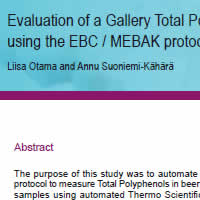Resumo do Pôster:
1. Introduction
Total polyphenols are becoming an interesting group of compounds because of their beneficial, antioxidant effects in food. There are currently several analytical methods for the total polyphenol measurement in the wine industry but due to the unspecificity of these methods the result levels differs from the EBC method used for beer and wort samples. In the brewing industry, polyphenols are considered as beer flavonoids such as the flavan-3-ols and their products, the proanthocyanidins, represent a class of readily oxidizable compounds capable of hindering or preventing the oxidation of other molecules present in beer (1). Total polyphenols are analyzed due to haze formation, primarily resulting from protein-polyphenol interactions within the product. Polyphenols are also one of the two chemical entities which control the colloidal stability of beer, the other being proteins.
In this study, the European Brewery Convention / Method Collection of the Central European Brewing Technology Analysis Commission (EBC/MEBAK) Total Polyphenol method (2,3) was adapted to a discrete photometric analyzer and automated method was optimized to 37 °C reaction temperature, which is the basic operation temperature in this analyzer. Results are reported in mg/L to the nearest whole number as gallic acid equivalent. Seven BAPS reference beers from LGC Standards were used as samples in method comparison. Advantages of analytical procedure automation include easier and faster measurement. It also enables small sample sizes with less waste.
2. Purpose
Automate the EBC protocol to measure total polyphenols in beer and wort samples using an automated discrete analyzer.
3. Method
Seven BAPS reference beers from LGC Standards were used as samples in method comparison. Reference samples included both lager and bitter beers. Assigned values for each sample were determined as statistical median of results reported by participants.
Reagents were prepared according to EBC protocol 9.11. Carboxymethyl cellulose/ ethylenediamine tetraacetic acid (CMC/EDTA) was prepared by weighting 1.0 g sodium CMC and 0.2 g disodium EDTA and diluted to 100 ml with H2O. Ferric reagent was prepared by weighting 3.1 g ammonium iron citrate with iron concentrate of 16% and diluting it to 100 mL with H2O. Ammonia reagent was prepared by diluting concentrated ammonia (d=0.92 g/mL) to deionized water with dilution ratio 1:39.
80 μL of CMC/EDTA reagent, 100 μL of sample and 65 μL of ammonia reagent were dispensed to the cuvette and blank was measured at 600 nm. 5 μL of ferric reagent was added and incubated in 420 s. The absorbance was measured at 600 nm. The analyzer computes sample concentration automatically. No additional sample pretreatment was needed for beer samples. Turbid wort samples were centrifuged before the analysis.
4. Results and Discussion
Precision was determined by measuring seven reference beer samples as ten replicates in five batches, total number of results being 50. Precision within run, between run and in total was determined for each sample. The total precision of the measurement for all samples were 2.4% or better. No significant variation was noticed between runs.
Method linearity was determined with reference beer samples in range of 79 - 199 mg/L. All samples were measured as three replicates. Samples analyzed were in range of 79 - 199 mg/L, with R2 higher than 0.99.
Seven BAPS reference samples from LGC Standards were analyzed with the photometric analyzer and results were compared to assigned value of inter laboratory results. Method comparison between total polyphenol performed by the analyzer and reference method performed by EBC Ferric method gave good correlation. Recovery rates varied within 94 - 106%.
Table 1. Total polyphenol BAPS assigned and analyzer measured values (mg/L) and Recovery % |
|
Sample |
Assigned value |
Measured value |
Recovery % |
Lager 1 |
199 |
198 |
99 |
Lager 2 |
75 |
74 |
94 |
Lager 3 |
110 |
108 |
98 |
Lager 4 |
135 |
136 |
101 |
Lager 5 |
103 |
101 |
98 |
Bitter 1 |
195 |
207 |
106 |
Bitter 2 |
142 |
133 |
94 |
5. Conclusion
The photometric method used in the analyzer for determinig total polyphenol in beer and wort correlates well with the EBC reference method. The advantage of using automated analyzer is the speed of analysis and the possibility to measure several analytes from the same sample in addition of total polyphenol measurement. This automated method can perform more than 100 total polyphenol measurements per hour with very little hands-on time.
6. References
- P. Aron and T. Shellhammer. A Discussion of Polyphenols in Beer: Physical and Flavour Stability. J. Inst. Brew. 116(4), 369–380, 2010.
- Analytica-European Brewery Convention (EBC): Total Polyphenols in Wort by Spectrophotometry, Methods 8.12 and 9.11.
- MEBAK Volume “Wort, Beer and Beer-based Beverages”. 2.17.1 - Total polyphenols.
|

